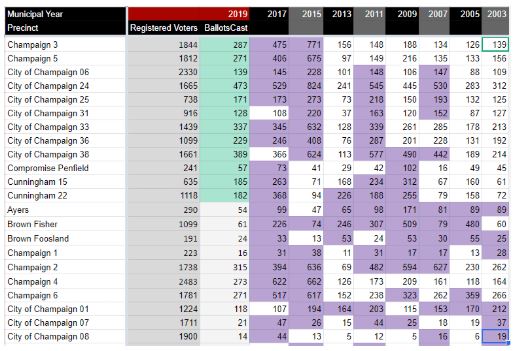Detailed election data from the Champaign County Voters Alliance showing precinct trends and more information from their latest meeting below (jump here). The News-Gazette had additional followup (see previous post here) from Tom Kacich's column Sunday comparing other counties and looking at election costs again:
Champaign County's puny 13.27 percent turnout for this month's local government election wasn't that much different than in other nearby counties.More at the full article here. Cost concerns were raised previously in his Mailbag feature last week From the Cheat Sheet: C-U Local:
Macon County, where there was a three-way race for mayor of Decatur, had a countywide turnout of 14.4 percent. Kankakee County's turnout was 12.8 percent. Madison County's was 11.8 percent. In McLean County, the turnout was 13.2 percent. Bloomington, which has a separate election commission, had a 9.37 percent turnout.
Danville, with a four-way race for mayor, had a 26 percent turnout, but the rest of Vermilion County was well below that.
Champaign County's was lower than comparable elections in recent years primarily because of the lack of a competitive mayoral race in Champaign. This year's election — led by incumbent Mayor Deb Feinen versus perennial candidate Azark Cobbs — drew just more than 7,000 voters in the city. That was far below the more than 12,000 who voted in a four-way race for mayor in 2015 (along with a school district tax increase referendum) and the 8,000-plus who voted in a two-way race between Don Gerard and Jerry Schweighart in 2011.
The low turnouts have raised anew concerns about the cost of these nonpartisan, consolidated elections. It's too early to calculate the cost of the election in Champaign County but it's worth noting that the county clerk's office has a budget of $130,000 just for election judges and workers. Divide that sum by the unofficial total of 17,014 who cast ballots and you have a cost of something like $7.60 per ballot cast.
Tom Kacich touched on this past municipal election in last week's Mailbag and an article yesterday. The Mailbag questions had to do with the additional costs of expanding voting access under the new Clerk, which will be certain to be of interest to future candidates running for the seat:It's hard not to see this as an early indicator that the next County Clerk race will have a vigorous debate on election budgets versus ensuring that money makes voting accessible to everyone that wishes to exercise the right. Low turnout elections will cost more per ballot, but there are probably few Democrats wanting to save money and rely on the assurances of Republican County Clerks that their constituencies will have reasonable access to the polls. From a previous Cheat Sheet post with one of the first changes by the new Democratic County Clerk:
The county operated eight remote early voting sites (in addition to the Brookens Center) in this election, the first one run by Democratic County Clerk Aaron Ammons. That's up from the six (plus Brookens) that were open in the 2015 consolidated election, run by Republican County Clerk Gordy Hulten.More at the full Qs and A here, including the County Clerk's view of the value of the expenditure.
There also were six days of remote site early voting this year, up from three days four years go.
Ammons estimated that the cost of providing early voting this spring was about $9,700, which includes salaries for election judges, facility fees, parking costs for judges on campus, fuel and staff costs to deliver election equipment and other assorted costs...
The cost of providing early voting in 2015 was estimated by Hulten at less than $5,000.
One early success appears to be working with the University to have student voting in a larger and more accessible first floor area of the Illini Union in future elections (including the Pine Lounge for this election). The previous County Clerk had assured the County Board that better spaces were neither available nor necessary to accommodate student voters prior to the election which resulted in long lines down winding staircases. Whether the changes will be enough to prevent bottlenecks in 2020 remains to be seen.
The recent Champaign County Voter Alliance meeting (during this week's extra day of winter and snow) included a more detailed break down of voting trends by precinct (in the Appendix on page 4):
The purple cells are ones with higher ballots cast than 2019. The white cells are lower ballots cast than 2019. Orange precincts are campus ones.
If I average ballots cast extending back to '03, then 12 more precincts qualify as having above average turnout (the teal colored ones below).
More details and information at the full meeting notes here, including what was discussed at the meeting itself with those able to make it.






No comments:
Post a Comment